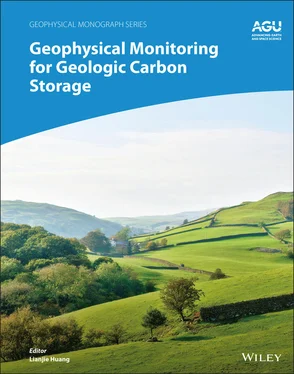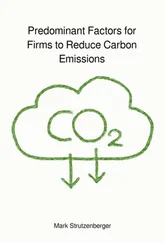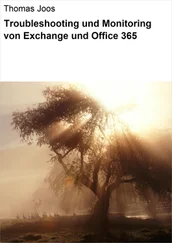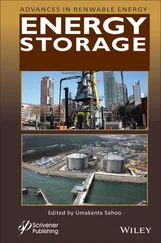Unlike the in situ instrument that would analyze a point source of atmosphere, the remote FMS instrument measured a column average of CO 2in the atmosphere. As one might expect, the CO 2stable isotope ratio changes with both the flux of CO 2that seeped to the surface along the observed column as well as due to changes in weather. This instrument was deployed in 2010 and 2011 and monitored δ 13C ~ ‐9% to ‐28% and δ 13C ~ ‐6% to ‐28%, respectively. Recall that the atmosphere has a natural CO 2stable isotope ratio of ‐7% and these results were in good agreement with background levels when seepage did not reach the surface. The instrument also recorded concentrations up to ‐28% ,about half of the maximum value observed by the in situ instrument and well below the ‐15% that would have clearly indicated seepage. While the remote instrument is capable of identifying the presence of a leak, it is not capable of determining the exact position or positions of the leak as a point source detector could.
Geologic sequestration of carbon dioxide is one method to permanently store CO 2industrial emissions and reduce the atmospheric concentration of this greenhouse gas. While some sequestered CO 2is expected to react with the surface of the reservoir and mineralize, much of the injected CO 2will remain as a fluid with the reservoir and monitoring, verification, and accounting for this CO 2is required. In this chapter, we described several available methods for monitoring CO 2emissions from a sequestration site from the surface. However, monitoring from the surface is complicated by natural CO 2emissions at the surface, and the diurnal cycle.
A wide variety of commercial and laboratory monitoring instruments have been developed and field tested. Passive and active absorption spectroscopy can measure the absolute concentration of atmospheric CO 2, and seepage from the sequestration site is derived from changes from the background diurnal concentrations. Absorption spectroscopy also has the advantage of point source in situ analysis as well as wide area remote analysis of the area above the sequestration site.
MVA methods that are capable of measuring the carbon stable isotope ratio have the advantage of distinguishing the anthropogenic CO 2from the sequestration site and the natural CO 2emissions. CRS and FMS are sensitive methods of accurately measuring the 13CO 2and 12CO 2ratio. While CRS is limited to in situ analysis on a collected sample, FMS has been done as both in situ and remote, open source, configurations.
The preparation of the manuscript was supported by the Laboratory Directed Research and Development Program at Los Alamos National Laboratory under project number 20180066DR. We gratefully acknowledge the Department of Energy, National Energy Technology Laboratory, for supporting the field work reported here.
1 Barr, J. L., Humphries, S. D., Nehrir, A. R., Repasky, K. S., Dobeck, L. M., Carlsten, J. L., & Spangler, L. H. (2011). Laser‐based carbon dioxide monitoring instrument testing during a 30‐day controlled underground carbon release field experiment. International Journal of Greenhouse Gas Control, 5, 138–145.
2 Bjorklund, G. C., & Levenson, M. D. (1983). Frequency modulation (FM) spectroscopy. Applied Physics B, 32, 145–152.
3 Costa, J. M., Grant, O. M., & Chaves, M. M. (2013). Thermography to explore plant‐environment interactions. Journal of Experimental Botany, 64(13), 3937–3949.
4 Dubinsky, I., Rybak, K., Steinfeld, J. I., & Field, R. W. (1998). Frequency‐modulation‐enhanced remote sensing. Applied Physics B, 67, 481–492.
5 Fessenden, J. E., Clegg, S. M., Rahn, T. A., Humphries, S. D., & Baldridge, W. S. (2010). Novel MVA tools to track CO2 seepage, tested at the ZERT controlled release site in Bozeman, MT. Environmental Earth Science, 60(2), 325–334.
6 Humphries, S. D., Nehrir, A. R., Keith, C. J., Repasky, K. S., Dobeck, L. M., Carlsten, J. L., & Spangler, L. H. (2008). Testing carbon sequestration site monitor instruments using a controlled carbon dioxide release facility. Applied Optics, 47(4), 548–555.
7 Johnson, W., Repasky, K. S., & Carlsten J. L. (2013). Micropulse differential absorption lidar for identification of carbon sequestration site leakage. Applied Optics, 52(13), 2994–3003.
8 Lindenmaier, R., Dubey, M. K., Henderson, B. G., Butterfield, Z. T., Herman, J. R., Rahn, T., & Lee, S. H. (2014). Multiscale observations of CO2, 13CO2, and pollutants at Four Corners for emission verification and attribution. Proceedings of the National Academies of Science, 111(23), 8386–8391
9 Reid, J., El‐Sherbiny, M., Garside, B. K., & Ballik, E. A. (1980). Sensitivity limits of a tunable diode laser spectrometer, with application to the detection of NO2 at the 100‐ppt level. Applied Optics, 19(19), 3349–3354.
10 Repasky, K. D., Humphries, S. & Carlsten, J. L. (2006). Differential absorption measurements of carbon dioxide using a temperature tunable distributed feedback diode laser. Review of Scientific Instruments, 77, 113107–1–5.
11 Rodosta, T., & Ackiewicz, M. (2014). U.S. DOE/NETL Core R&D Program for Carbon Storage Technology Development. Energy Procedia, 63, 6368–6378.
12 Rodosta, T., Ackiewicz, M., & Albenzec, E. (2014). Status Update and results from the U.S. Department of Energy Regional Carbon Sequestration Partnership Initiative. Energy Procedia, 63, 6039–6052.
13 Song, K. & Jung, E. C. (2003). Recent developments in modulation spectroscopy for trace gas detection using tunable diode lasers. Applied Spectroscopy Reviews, 38(4), 395–432.
14 Soukup, B., Repasky, K. S., Carlsten, J. L., & Wicks, G. (2014). Field demonstration of a 1 × 4 fiber sensor array for subsurface carbon dioxide monitoring for carbon sequestration. Journal of Applied Remote Sensing, 8, 083699‐1–12.
15 Spangler, L. H., Dobeck, L. M., Repasky, K. S., Nehrir, A. R., Humphries, S. D., Barr, J. L., Keith, C. J., et al. (2010). A shallow subsurface controlled release facility in Bozeman, Montana, USA, for testing near surface CO2 detection techniques and transport models. Environmental Earth Sciences, 60(2), 227–239.
16 Supplee, J. M., Whittaker, E. A., & Lenth, W. (1994). Theoretical description of frequency modulation and wavelength modulation spectroscopy. Applied Optics, 33(27), 6294–6302.
17 Votsmeier, M., Song, S., Davidson, D. F., & Hanson, R. K. (1999). Sensitive detection of NH2 in shock tube experiments using frequency modulation spectroscopy. International Journal of Chemical Kinetics, 31, 445–453.
18 Webster, C. R., & Mahaffy, P. R. (2011). Determining the local abundance of Martian methane and its 13C/12C and D/H isotopic ratios for comparison with related gas and soil analysis on the 2011 Mars Science Laboratory (MSL) mission. Planetary and Space Science 59(2), 271–283.
19 Werle, P., Miicke, R., & Slemr, F. (1993). The limits of signal averaging in atmospheric trace‐gas monitoring by tunable diode‐laser absorption spectroscopy (TDLAS). Applied Physics B, 57, 131–139.
20 Yang, Q., Zhao, W., Dixon, T. H., Amelung, F., Hanc, W. S., & Li, P. (2015). InSAR monitoring of ground deformation due to CO2 injection at an enhanced oil recovery site, West Texas. International Journal of Greenhouse Gas Control, 41, 20–28.
21 Zalicki, P., & Zare, R. N. (1995). Cavity ring‐down spectroscopy for quantitative absorption measurements. Journal of Chemical Physics, 102, 2708–2717.
Part II Subsurface Seismic Monitoring
4 Optimal Design of Microseismic Monitoring Network for Cost‐Effective Monitoring of Geologic Carbon Storage
Ting Chen and Lianjie Huang
Читать дальше












